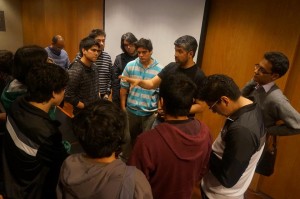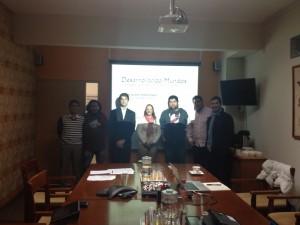Making Games in Peru, 5: A Perfect Storm
As the summer draws to a close, so has my time in Lima. For the last three months I’ve been fortunate enough to meet and follow lots of people in the local video games industry as they crunch through games, try to open up markets and bring together the various players in the industry who have been scattered about for so long. Making games in Peru is not easy, and big challenges abound. But despite the perception many people have of games as risky business, there have been many efforts coming together in the last few months that point to very interesting prospects in this space.
Just a few weeks ago, the local chapter for the International Game Developer Association was celebrating its first birthday. IGDA Peru has been operating as a highly effective beacon: for a long time, people interested in game design and development simply had nowhere to turn to for information on how to get started, how to acquire skills, where to look for jobs, and so on. This information vacuum to a large extent contributed to the high perception of risk: without really knowing what was going on in the industry, most people defaulted to the belief that there simply was no local industry to speak of. For many local game development studios it was even the case that they operated without being fully aware of who else was out there, often facing many of the same challenges. For a long time, the map to the Peruvian games industry resembled the first few minutes of the map to a real-time strategy match: some isolated bases scattered across the landscape, and a whole lot of fog of war covering everything else in between.

The emergence of IGDA Peru introduced a point of reference for all players on the map, and for many other characters who were trying to figure out the geography. Over time, people interested in getting involved with the gaming industry began acknowledging IGDA Peru as the default point of entry, through a series of events and activities put together by a small but dedicated team with a diverse background – most of them either working at or otherwise connected to some local studio. Local game jams, conferences, workshops and meetups all offered for the first time opportunities for newcomers to actually witness what making games looked like and to become a part of the production process without having to jump all in (say, by trying to look for a job in the industry). Just as importantly, these meetups provided opportunities for people to engage each other face to face and start building relationships, something the local community had been ineffective at providing through its early history. These relationships have become a key asset for the local industry, becoming the foundation for knowledge circulation, problem solving, and many new projects, collaborations and studios. The growing importance for these interactions can be observed directly through a Facebook group created and managed by IGDA Peru, where technical questions, project announcements and job postings circulate on a daily basis amongst over 1300 members.
IGDA Peru has positioned itself as a great resource for people working or interested in working in the industry. But other collaboration spaces have begun to emerge for studios, signalling an important shift in how the industry operates. After working for a long time as relatively isolated efforts, the last few weeks saw the formation and first meetings of the Peruvian Software Association’s Video Games Chapter, a new forum representing the business interests of some of the most active studios in the local scene. The formation of the Video Games Chapter arrives symbolically as the moment when the Peruvian gaming industry has become self-aware: studios have become aware not only of each other, but also of the need for coordinated action if they are to continue to grow as an industry. The sector faces many structural challenges, none of which any studio can influence alone, and many of which require the successful engagement of government to produce meaningful solutions.

The VGC has begun to consider these broader issues, while it also provides a baseline level of coordination that many government agencies demand before providing any incentives or support. Because of the regulations around the use of government funds, no support can be provided for any individual company. To gain access to the opportunities and support other industries are getting, the government demands some level of representation of the sector’s interests, and the formation of the VGC intends to be a response to that as well.
While these are all positive signs, the near-term future of the Peruvian gaming industry can best be described as a “perfect storm”. The country’s economic growth has recently started to slow down, which means the amount of resources that will be available in the next few years for strengthening new technology and creative industries will probably diminish. And because the industry still hasn’t reached critical mass, the long-term effects of new instances of collaboration failing to meet expectations could severely hurt the future of the industry. Collaboration is necessary for the industry to grow to its next stage. But at the same time, it is necessary for that same collaboration to be successful if the industry wants to be something more than an interesting footnote. Such are the conditions for this perfect storm: it is a critical time for the video games industry in Peru, and how the navigate their immediate challenges will make or break an entire new creative industry.
Over the last three months, I was down in Lima working with people in the gaming industry, and gathering the data that became the basis for this series of posts. While my fieldwork is over for now, this data is part of a larger research project around my master’s thesis in Comparative Media Studies, and as such, I’m very interested in hearing about any feedback, comments or questions from readers. If you have any thoughts, you can reach me over e-mail at emarisca [at] mit [dot] edu.
As this series comes to a close, I especially want to thank the support of the Department of Comparative Media Studies / Writing at MIT, which has made this research possible through a travel grant, and the MIT Game Lab for providing me with a space to share these thoughts and observations. And of course, very special thanks go out to the many people who generously gave me their time and allowed me into their homes, offices and personal stories, to reconstruct the history and draw a map to the art and industry of making video games in Peru.
